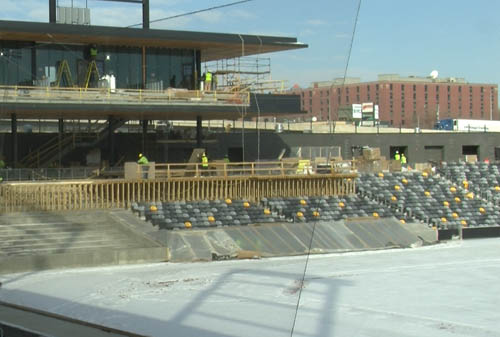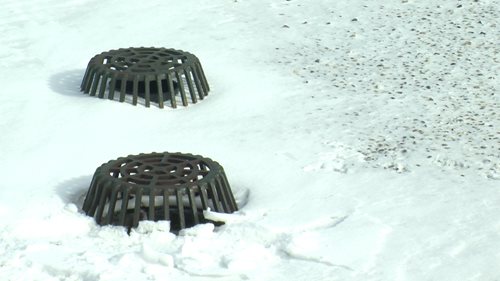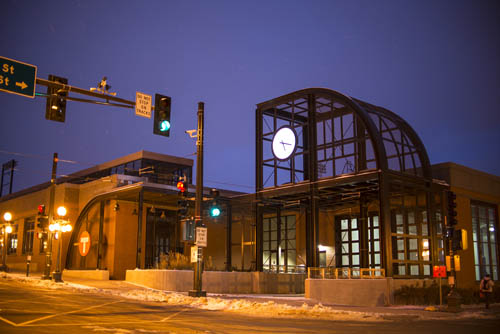When the new Saint Paul Saints baseball park opens in May, sideshow antics and local beer won’t be the only innovative things on tap.
CHS Field also will host a sustainability feature that captures rainwater from the rooftop of Metro Transit’s adjacent METRO Green Line Operations and Maintenance Facility. The water will be used to irrigate the ball field and grounds, and for some of the stadium’s toilets.
Project will substantially reduce demand on city water
The project will substantially reduce the site demand for potable city water and will reduce runoff to the Mississippi River. It’s a joint effort of the City of Saint Paul, the Saints, the Capitol Region Watershed District, and the Metropolitan Council.
The system is a sign of the times as long-range water concerns creep up in the region.
“It’s a win-win for everyone and a great demonstration project for future developers,” said Brian Davis, an environmental scientist with the Metropolitan Council who is helping bring the project to life.
 “It is becoming increasingly clear that water is a valuable and limited resource, and we should conserve it whenever we can,” Davis said. “As an environmentally conscious organization, the Council encourages water recycling projects like this and hopes to see similar projects in the future.
“It is becoming increasingly clear that water is a valuable and limited resource, and we should conserve it whenever we can,” Davis said. “As an environmentally conscious organization, the Council encourages water recycling projects like this and hopes to see similar projects in the future.
“With 900,000 new residents in the region by 2040 and limited water supplies in some parts of our region, we need to think about and plan for the 22nd century right now,” he said. “This is a small step in that direction.”
Construction ramps up for May 21 opening
Davis said this demonstration project is possible due to the confluence of public support, technology, automation, miniaturization of complex parts (like control panels), and new mobile, high-tech remote control technology.
Planning and preliminary work on the system began well over a year ago. More work ramps up in February toward the May 21 opening of the $63 million ballpark.
Total cost of the rainwater harvesting system is $300,000, funded by grants from the Minnesota Clean Water Legacy Fund.
From rooftop to ballpark lawn
 The rainwater will be collected from a portion of the rail facility. In a one-inch rainfall, the 0.8-acre collection area on the roof will capture 21,000 gallons of water for reuse.
The rainwater will be collected from a portion of the rail facility. In a one-inch rainfall, the 0.8-acre collection area on the roof will capture 21,000 gallons of water for reuse.
From the rooftop, the water flows into a 27,000-gallon steel tank below the ballpark concourse.
After it is filtered and sterilized with ultraviolet light, the water will offset 15% to 20% of potable demand for the ball field and will be used to flush 10% of the facility's toilet fixtures. The rest will come from city water.
Landscape plans for the site include rain gardens, tree trenches, and swales that also soak up stormwater. Other elements include environmental design features and solar panels that reduce electric demand.
Project is demonstration in dense urban environment
The project is one of the first in Minnesota to recycle rainwater for human use indoors. In addition to meeting regulatory requirements, project planners also had to overcome numerous physical challenges designing the system in a dense, urban environment.
 “Harvesting rainwater between properties and using it for multiple purposes demonstrates an extraordinary commitment to sustainable water resources,” said Wes Saunders-Pearce, water resource coordinator for the City of Saint Paul, who worked a long time finding the right project for such an application.
“Harvesting rainwater between properties and using it for multiple purposes demonstrates an extraordinary commitment to sustainable water resources,” said Wes Saunders-Pearce, water resource coordinator for the City of Saint Paul, who worked a long time finding the right project for such an application.
“Identifying a suitable project that can consume large amounts of runoff generated from an urban environment was very challenging,” he said. “In fact, multiple benefits for a water reuse project had to be identified, otherwise there is little justification for the added expense. Also, finding space to store large volumes of rainwater was a challenge.”
Both the Council and the City have high hopes for the project’s future impact.
“We’re using sustainable design to help brand a new local landmark, and educating a wide audience about water pollution and conservation,” Saunders-Pearce said.
“Perhaps most important, we’re removing barriers and demystifying an important tool for better site design and water conservation.”
Read more at CHS Field online.
Stormwater Reuse Guide (zip file for download).
Stormwater reuse is one of several sustainable features at rail facility
Formerly a vacant Gillette Co. storage building, the Operations and Maintenance Facility opened in 2014. More than 200 Metro Transit staff, including operators, mechanics and cleaners, work at the facility. The building is also used to store and maintain 37 light-rail vehicles.
The $49.4 million building includes several sustainable features, such as automated heating and cooling controls, exhaust systems with energy-recovery technologies, and motion-triggered lighting. Heated and chilled water supplied by Saint Paul-based District Energy is the primary energy source for warming and cooling the facility. Hot water circulated through concrete in front of the building also melts ice from rail tracks.